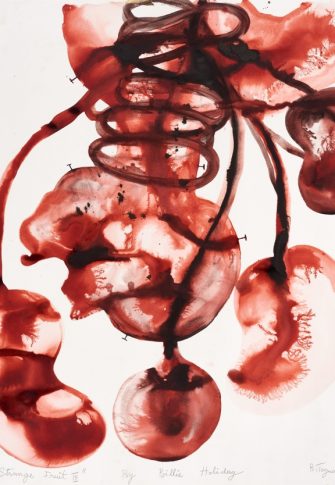Stevenson, Cape Town
23.01 – 07.03.2020
‘Bilongue’ by Barthélémy Toguo, showing at Stevenson Cape Town, is made possible by what Afro-American scholar Saidiya Hartman called the “afterlife” of – or residue of – the Cameroonian colonial encounter. Toguo tells a tale of characters struggling against the grain, haunted by the specter of desperation and material want, as well as a life of the post-colony punctuated by blinding beauty and joy. Executed with charming simplicity, this project features watercolor pieces of figures soaked in blood-red and cold blue, delicate wood carvings of serene faces, ink drawings peopled with black and white faces with splashes of a purple hue. The portrait form is employed to (1) augment Togou’s dominant motifs, and interestingly, to (2) eclipse the standardized and conventional ways of seeing, which is to say, gazing. I argue that what Toguo refers to as “to go towards the other […] with empathy”, is what cultural theorist Christina Sharpe calls, in another register, “wake work” as a form of “care” (In The Break: On Blackness and Being); those whose Living strangely mingles with Dying, whose Life is tragically intimate with Death.
The Framing of Time
Colonial O’clock. The swift-lines ink drawings of faces sparingly smeared with color, like all the faces in this body of work, are modern day people of Douala, Cameroon, whose existence Toguo thought fitting to immortalize on mounted paper. The drawings are easily digestible at first glance but prove complicated upon the realization that the purple people portrayed have photographs glued to the center of their faces. The glued images are pre-independence archival material; mostly monochrome gems, they are a pictorial exposition of colonial settlements and plantations, school yards, natives gathered in groups, with one featuring a band of black boys bonding over books. This juxtaposition exposes the ways in which photography is/was symbolic of the narcissism of the colonial enterprise and is/was weaponized against the colonized, to, primarily, mark colonial territory and time.
The persistent past that is not yet past and the present clash, crash, collide. The meaning(s) of the drawings, synonymous with the narrative(s) of the face/s, acquire a new significance; time is temporarily suspended, and because the photographs are situated close to or over the eyes, the colonial past is seen through the eyes of the experiential lens of the modern day Cameroonian, who now becomes an active agent in the interpretation of “his- or her-story”, as art critic Njabulo Zwane puts it.
Further, Togou makes an impressive aesthetic leap in the form of borders, or implied frames, around the drawings using text (the texts are a thread that frames not only the series of drawings but the exhibition space as well). The text, as border, assumes the form of postal stamps, evoking Kodwo Eshun’s theorization of postal stamp aesthetics, in relation to his collaborative cinematic effort ‘The Year One’; how stamps are linked with the suspension of time, an arrest of an epochal moment. (Togou, in an interview with Virginie Andriamirado, also recounts a time he employed this ‘postal stamp’ aesthetic on an art project in Serbia and Kosovo, with the aim of allowing the narratives to transcend space and reach other countries).
The postal stamp aesthetics are symbolic of the tendency of narratives to transcend not only space but time as meanings-in-transit. This indubitably upsets the Western public discourse and framing of post-colonial Africa (continent-in-crisis) as a regression to a pre-colonial temporal domain and temporal stagnancy, all at once. Postal stamps have an effect of sharing or being shared, suggestive of what attorney and artist Rasheedah Phillips called a “communal historical memory” (The Funambulist 24 // Futurisms).
The Framing of Memory
The body re-members.The Bilongue community is curved dexterously on Zingana trees, native to Toguo’s home turf, Bandjoun. The folds in cloths are smooth, contrasted with the rough texture of body hair. The figures are calm, with some exaggerated and slightly disfigured facial parts. Toguo subverts the ancient African mask to create pictorial and lively portraits, fitted nicely with the engraved frames remarkable for their uneven measurements. The chosen material, wood, does well to extend his motif of the interconnected of human life with nature/ecosystems. This connection is most apparent and striking in his signature watercolors (mellow in tone) of bodies and objects pulling each other, together in the connectedness, drenched in blue (The Solitary Gardner in the Baril 2016), drenched in red, with floating text, wisdom of common people rooted in a collective moral compass disintegrated by the colonial onslaught. This connection is the ancestral bond which has found its voice through the text-as-subtitles creating an enchanting cinematic vignette of the post-colony.
The series stands as an impressive body of work that is multilayered yet humble, sensitive, and achieves its main objective: to excavate the past of the living, the dead/nonliving, as an act of resistance and refusal, a refusal of colonial production of time. And to do so with tremendous care, ‘empathy’, as Toguo puts it. To defend them by defending their memory.










